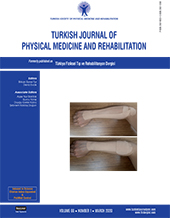The prevalence of sarcopenia risk and associated factors in patients aged 65-79 years living in a district of Izmir province of Turkey
Patients and methods: This cross-sectional study used a cluster sampling method to define sarcopenia risk and associated factors in population aged 65-79 years in Balcova district and a total of 254 participants (114 males, 140 females; mean age 70.0 years; range 65 to 79 years) were included between October 2014 and December 2014. The dependent variables were low gait speed (LGS), low grip strength (LGrS), having both LGS and LGrS, sarcopenia risk according to the European Group on Sarcopenia for Older People (EWGSOP) algorithm. The independent variables were socio-demographic and socio-economic variables, health-related behavioral factors, and health status variables. The gait speed was measured on a four-meter length with a stopwatch. The grip strength was measured using a hand-held dynamometer. The logistic regression models were used to identify associated risk factors for sarcopenia.
Results: The prevalence of LGS was found to be 45.0%, LGrS to be 49.8%, having both LGS and LGrS to be 30.1%, and sarcopenia risk according to EWGSOP to be 64.8%. The main associated factors of having any sarcopenia risk were increasing age and having a sedentary lifestyle or being underactive.
Conclusion: Our study results show that sarcopenia risk is high in a community-dwelling elderly population living in Balcova district of Izmir province of Turkey. Physical activity levels of elderly should be increased to decrease this high burden.
Keywords : Elderly, hand strength, prevalence, sarcopenia, walking speed
















